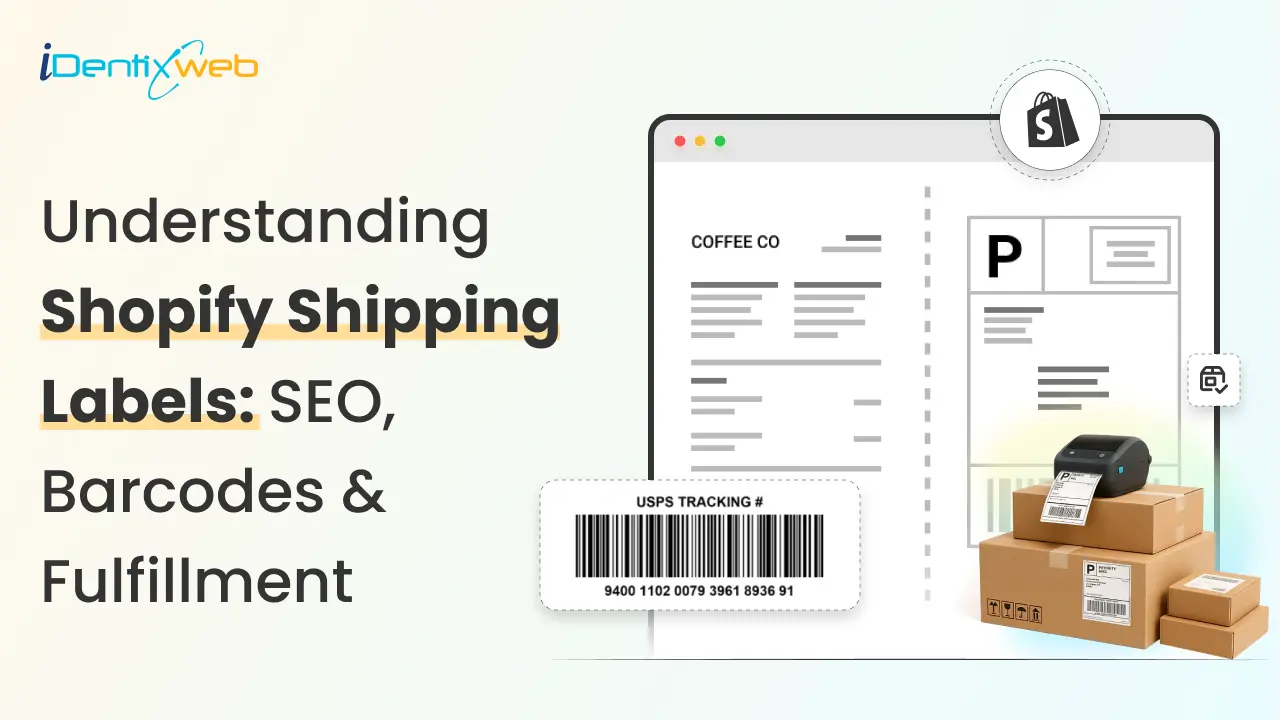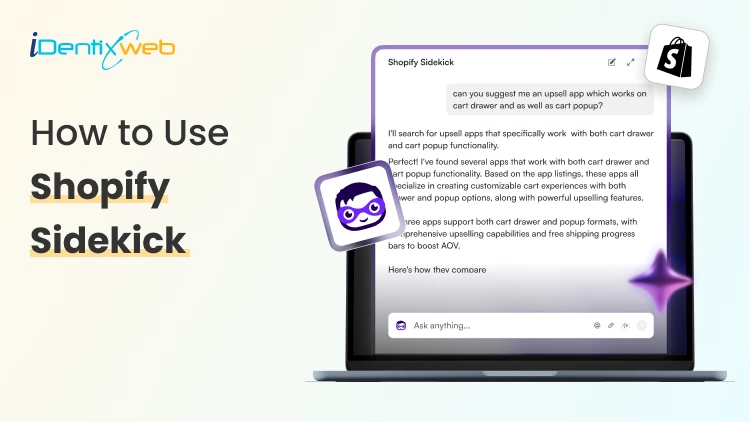
Your Shopify shipping label isn’t just a sticker. It helps shoppers choose the right variant, helps your team ship the right item, and keeps your Shopify data accurate.
When labels match your store data, pick up, packing, and returns all get faster and smoother.
Why labels matter?
Labels connect what customers see, what operations use, and what Shopify stores in its system.
Titles and variants are what customers see. SKUs, barcodes, and batch details are for the operations team. The fields inside the Shopify shipping label are the system of record.
When these three parameters match, you will avoid missed pick-ups, cut down on “where’s my order?” emails, and make product discovery on your store more readily available.
What do good Shopify shipping labels include?
A useful label matches what the buyer sees at checkout. Show the product title and variant exactly as listed, keep the SKU readable, and make sure the barcode is large enough and readable so it scans the first time.
If your Shopify store sells products with batch numbers or expiry dates (like food, cosmetics, or medicines), you should not manually type those details (e.g., typing “Batch #123, Exp: Jan 2026” in the product description or notes).
Instead, you should store and track that information properly using real data fields in Shopify.
When you sell product bundles (for example, a “Self-Care Kit” that includes shampoo, soap, and lotion), the people packing the orders should know exactly which items go inside that bundle.
Set up your Shopify fields first
Labels only work if your data is clean. Standardize how you name products and variants, then stick to it.
Details such as fabric, ingredients, or batch numbers belong in structured fields. If you need extra attributes, add them as Shopify metafields so they’re reusable in labels and on product pages.
Here’s a simple, easy-to-understand introduction to Shopify customer metafields. When many SKUs share the same spec block or size chart, store it once and reuse it with metaobjects to keep everything in sync: Shopify metaobjects.
After that, your label template can automatically grab title, variant, SKU, barcode, and any handling notes without manual edits.
Barcodes, GTINs, and where they live
Think of SKU as your internal code and barcode/GTIN (UPC or EAN) as the external one marketplaces expect.
If you sell on channels that validate GTINs, source real ones and keep them tidy, GS1’s overview of the Global Trade Item Number (GTIN) explains how they’re assigned and used.
In Shopify, add the barcode to the Barcode field so it appears in POS, exports, and printing apps; Shopify’s guide on understanding barcodes covers accepted formats and where to store them.
Print without extra work
Build labels from Shopify fields, not one-off text boxes. Keep the barcode clear with enough blank space around it, and avoid glossy surfaces or extreme curves that cause misreads.
If you print in waves, add a small timestamp or batch ID so staff can spot older labels at a glance. When your packing slip and label pull the same fields, packers don’t have to rewrite anything.
This walkthrough on How to print Shopify shipping labels together with custom forms shows how to keep paperwork consistent.
Scanning that prevents mistakes
Scanning adds a quick “are we sure?” step at receiving, picking, and handoff.
A simple tablet or phone at the packing table can compare the barcode to the Shopify line item before the box is sealed. If you’re building your own tool, there are practical examples for reading product labels that fit neatly into a lightweight in-house kiosk or mobile flow.
Once your warehouse or store starts using barcode scanning (for inventory and order management), several operational improvements happen automatically
- Receiving terms are scanned and instantly matched to the correct purchase orders (POs)
- Pickers stop grabbing products that look similar but are actually different (like two similar shampoo bottles)
- Local pickup becomes smoother.
- Returns are simpler because scanning helps identify the exact product that needs
Make labels help SEO (without tricks)
Your labels and storefront should say the same thing. Consistent variant names make collections, filters, and internal search work better.
Favor clarity over clever nicknames on labels, and keep that same clarity in Shopify. If you want to see the impact, use plain English. You can leverage Shopify Analytics to grow your Shopify store. This is a handy tool for measuring what matters.
Where labels earn their keep in fulfillment?
A straightforward flow works well. When goods arrive, scan the PO and the barcode; if the GTIN is missing, add it once so the next delivery is clean.
During putaway, print new shelf labels if locations change, so pickers don’t have to search. While picking, scan each item to confirm size, color, or finish before it goes into the tote. At packout, print a label that matches what the customer saw in checkout.
For local pickup, do one last scan to mark the order picked up. If you’re mapping the bigger picture, so ops, support, and marketing are aligned, this order management in ecommerce overview ties the pieces together.
Returns and exchanges
Inconsistent names slow down the support. If Shopify says “Azure / L,” the shelf says “Blue / Large,” and a label says something else, agents waste time translating before they can help.
Keep the same words everywhere. If you track batches or lots, include them on labels so recalls and replacements are precise.
Common pitfalls and quick fixes
Hard-to-scan barcodes usually come from tiny sizing, glare, or curved surfaces. If the packaging forces a curve, place the barcode on a flat surface with additional support.
Fancy formatting is another issue; a label’s job is clarity, not branding, so avoid mixed fonts and crowded text. Finally, resist freeform notes. If a detail matters, make a real field for it in Shopify so it stays consistent across prints and shows up in your reporting.
Wrap-up
Product labels in Shopify carry more weight than you might think. Clean fields lead to consistent templates, and a quick scan keeps orders accurate.
Keep names consistent, use Shopify fields, metafields and metaobjects for details, and let scanners do the work for you.
You’ll see fewer errors, faster handoffs, and happier customers while your ops stay simple and scalable.
Shopify Shipping Labels FAQs
1. Can I create a shipping label on Shopify?
Yes. If you’re shipping from a fulfillment location eligible for Shopify Shipping, you can buy and generate shipping labels directly from the Shopify admin without needing a third‑party tool.
2. How to create a shipping label on Shopify?
From the Shopify admin or mobile app, go to the specific order, select “Create shipping label,” choose your carrier and shipping service, then purchase and print the label.
3. Can you print shipping labels on Shopify?
Yes. Once you purchase a label, you can print it right from your desktop or mobile device using a compatible printer.
4. How to void shipping labels on Shopify?
You may void a shipping label from the Orders > Shipping labels page before the carrier scans it, and the label cost is credited back to your account.
5. How much are Shopify shipping labels?
The cost of Shopify shipping labels varies by package weight, dimensions, destination, and carrier.



![How to Help ChatGPT Discover Your Products? [Updated Methods] How to Help ChatGPT Discover Your Products? [Updated Methods]](https://www.identixweb.com/wp-content/uploads/2025/12/18-12-Thu-Blog-How-to-Make-Your-Shopify-Store-Appear-in-ChatGPT_-1.webp)
![How to Lock a Shopify Store With a Password? A Complete Guide [2026] How to Lock a Shopify Store With a Password? A Complete Guide [2026]](https://www.identixweb.com/wp-content/uploads/2025/12/18-12-Thu-Blog-How-to-Set-up-Markets-on-Shopify.webp)

About the author
Vineet Nair
Vineet is an experienced content strategist with expertise in the ecommerce domain and a keen interest in Shopify. He aims to help Shopify merchants thrive in this competitive environment with technical solutions and thoughtfully structured content.